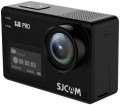Ultra HD (4K)
The ability of the camera to shoot Ultra HD 4K video.
This format covers several resolutions in which the horizontal frame size is approximately 4K pixels. The most popular in action cameras is 3840x2160 (twice the FullHD frame on each side), but there are other options — for example, 3840x1920, corresponding to an aspect ratio of 2:1. In general, 4K is a kind of successor to Full HD: among HD standards that surpass Full HD, UltraHD is the most popular, in particular, many advanced TVs are produced with 3840x2160 screens. On the other hand, this format is quite demanding in terms of processing power and memory, so it is relatively rare in action cameras, mainly among premium models.
Another important parameter given in this paragraph is the frame rate. The higher it is, the smoother the movement in the frame will be, and the details in dynamic scenes will be visible clearly. However, in UltraHD mode, most modern action cameras produce a very low frame rate — most often
30 fps, and in some models
24 fps or even
15 fps. This video is quite viewable, but fast movement in the frame may look blurry. There are cameras capable of shooting UltraHD at a solid speed of
60 fps — the blurring effect during such shooting is almost imperceptible. However, such a model cost is high.
Sensor
Additional information regarding the sensor installed in the lens. This item can specify both the diagonal size (in inches) and the sensor model, and sometimes both parameters at once. Anyway, such data is provided only if the device is equipped with a high-class image sensor. With the model, everything is quite simple: knowing the name of the sensor, you can find detailed data on it.
The diagonal of the image sensor is traditionally indicated in fractions of an inch — accordingly, for example, a 1/2.3" sensor will be larger than 1/2.6". Larger sensors are considered more advanced, as they allow for better image quality at the same resolution. This is because due to the larger sensor area, each pixel is also larger and receives more light, which improves sensitivity and reduces noise. Of course, the actual image quality will also depend on several other parameters, but in general, a larger sensor size usually means a more advanced camera.
Connection
—
GPS module. Built-in satellite navigation module that allows you to determine the current coordinates of the device. Options for using data from GPS can be different: geotagging footage, recording travelled routes, determining the speed of movement, or even full-fledged navigation on the map.
—
Wi-Fi module. The Wi-Fi wireless module in action cameras can be used in different formats: in some models, it is responsible for connecting to the Internet, in others it is for communicating with a smartphone or other gadget, in others both options are available at once. Anyway, the main use of this connection is to transfer footage to an external device or to the Internet (including broadcasting in the online streaming format, see “Filming capabilities”). In addition, more specific functions can be provided, for example, using a smartphone as an external viewfinder and remote control. Specific features of the use of Wi-Fi in each case should be clarified separately.
—
Bluetooth. Direct wireless communication technology for exchanging information between two electronic devices. In action cameras, it is most often used to connect remote controls, selfie sticks and smartphones, which can also act as a remote control. Unlike the Wi-Fi module, it consumes battery power more economically, but at the same time, the range of wireless communication is reduced to 10 m
...etres.
— NFC chip. NFC is a wireless communication technology over short distances (up to 10 cm). In action cameras, this technology is mainly used as an auxiliary one, to facilitate connection with a smartphone or other gadget via Wi-Fi or Bluetooth. If such a gadget is also equipped with NFC, just bring the camera to it and confirm the connection — it's easier than fiddling with the settings.
— USB-C. A relatively new type of USB interface that uses a miniature double-sided connector, slightly larger than microUSB. Most often used for similar purposes — as a universal connector through which you can charge the battery and connect the camera to a computer (for copying photos and videos, updating software, etc.). P.). At the same time, USB-C provides a higher data transfer rate than microUSB, supports more power supply, and also has a more convenient plug. Occasionally, there are more specific ways to use this interface — for example, direct connection to a smartphone or tablet that has a USB-C port.
— HDMI output. HDMI is a digital interface specially designed for high-definition video and multi-channel audio. With this output, you can connect the camera to a TV, monitor or other device as an external player and play the footage directly. The convenience of HDMI is that almost all modern video equipment with support for HD standards is equipped with such inputs.
Note that the cameras can be equipped with a smaller version of the connector — miniHDMI or microHDMI; however, finding an adapter cable is usually not a problem, it can even be supplied in the kit.
— Microphone connection. Almost any modern action camera has a built-in microphone that allows you to record sound. However, the quality of its sound is often quite low. Thus, many models can connect an external microphone — you can fix it, for example, on the helmet strap and record the comments of the athlete in the process of movement. Note that different types of connectors can be used for such a connection. As a result, the specific connector type and supported accessories depend on the action camera model, and some devices are only compatible with branded microphones.
